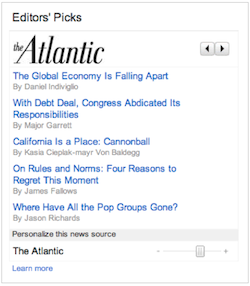When Google News launched in 2002, it did so with some declarations: “This page was generated entirely by computer algorithms without human editors.” And: “No humans were harmed or even used in the creation of this page.”
 That core approach — computerized curation, algorithmic authority, NoMo sapiens — has served Google News well in the nearly-a-decade it’s been around, providing users with the multifaceted view of human events that is the news site’s hallmark. (Not to mention a reach that, Google claims, sends over 1 billion clicks a month to news publishers worldwide.)
That core approach — computerized curation, algorithmic authority, NoMo sapiens — has served Google News well in the nearly-a-decade it’s been around, providing users with the multifaceted view of human events that is the news site’s hallmark. (Not to mention a reach that, Google claims, sends over 1 billion clicks a month to news publishers worldwide.)
But the thing about humans is that, occasionally, they’re helpful to have around. Especially when it comes to the increasingly difficult task that is keeping track of the world as it twists and turns. Which is why, starting today, Google News is introducing a new section to its U.S. edition: Editors’ Picks, a display of original content that journalists (human ones!) have selected as editorial highlights from their publications.
The feature, which will live on the right-hand column of the Google News page, “is the latest addition to recent improvements we’ve made to the variety and presence of stories and multimedia on Google News,” software engineer Yogita Mehta notes in a blog post announcing the section. But “because Google News relies on algorithms, Editors’ Picks will always be just that — picks provided by publishers themselves, and not by Google.”
![]() That’s a big deal, and only partially because of Google News’ traditional algo-centricism. Editors’ Picks is Spotlight-like in its ability to highlight “in-depth pieces of lasting value” — but it’s unique in that it defines value according to the judgment, and needs, of human editors. (If Editors’ Picks sounds familiar, that’s because it is: We actually wrote about it last June, when Google launched it as a temporary experiment. Google used the data it gathered from that experiment to develop Editors’ Picks into the standing section it’s becoming today.)
That’s a big deal, and only partially because of Google News’ traditional algo-centricism. Editors’ Picks is Spotlight-like in its ability to highlight “in-depth pieces of lasting value” — but it’s unique in that it defines value according to the judgment, and needs, of human editors. (If Editors’ Picks sounds familiar, that’s because it is: We actually wrote about it last June, when Google launched it as a temporary experiment. Google used the data it gathered from that experiment to develop Editors’ Picks into the standing section it’s becoming today.)
Now that it’s launching in a (more) permanent capacity, Editors’ Picks offers an opportunity for publishers to take their news judgment — not to mention the nice serendipity that judgment can offer to news consumers — and amp up its impact. Google has teamed up with news outlets both national and niche — nearly two dozen so far, among them Slate, National Journal, the Wall Street Journal, The New York Times, ProPublica, BBC News, MSNBC.com, Reuters, the Los Angeles Times, The Root, Politico, MarketWatch, and The Guardian — to display the content, five items at a time, that the outlets’ editors most want to be seen by Google News’ audience. That content can be enterprise stuff that could use an extra push within a given news cycle; entertaining stuff that might have the potential to go viral; or just, you know, good stuff — content that’s unique or surprising or simply important — that could benefit from more exposure on Google’s uber-trafficked platform. (Since Editors’ Picks works through a custom RSS feed, that content could also include features like slide shows, videos, or topic pages that Google News might not otherwise index.)
For Google, there’s a definite two-birds-one-section element to all that: In addition to providing users with more good content, Editors’ Picks might also pave the way for more effective partnerships with news publishers. While Google’s relationship with the news industry has been a rocky one, Editors’ Picks suggests that it could now be turning a corner — from passive collaboration to active, from algorithmic connection to something more intentional. And, yes, human. Editors’ Picks is yet another instance of Google News working directly with news organizations to test what can happen when humans and technology team up to tell stories. Plus, it’s kind of hard for publishers to complain about Google News stealing their content when they’re actively working with Google News to promote that content. (Speaking of, if you want your outlet featured in Editors’ Picks, check out Google News’ Help Center for more info.)
For publishers, Editors’ Picks is also a way to highlight brand identity within a platform that has tended to emphasize news stories over news institutions. On Google News’ main section (and on most of its right-column features, too), headlines are presented in big, blue hypertext while their sources are denoted in small, gray plaintext. From the UI perspective, that’s great: When you’re taking in the news, you generally care way more about the headlines than about the outlets that produced them. But Editors’ Picks marks a shift: It allows users to browse a set of publisher feeds via side-to-side navigation arrows that are located smack next to the publishers’ logos. While the feeds presented are determined by a variety of factors, including personalization preferences…the fact that they’re there in the first place allows Google News users to explore news content according to news outlet. It emphasizes the news brand as much as the news story.
It takes the notion of serendipity, in other words, and applies it to news organizations themselves.